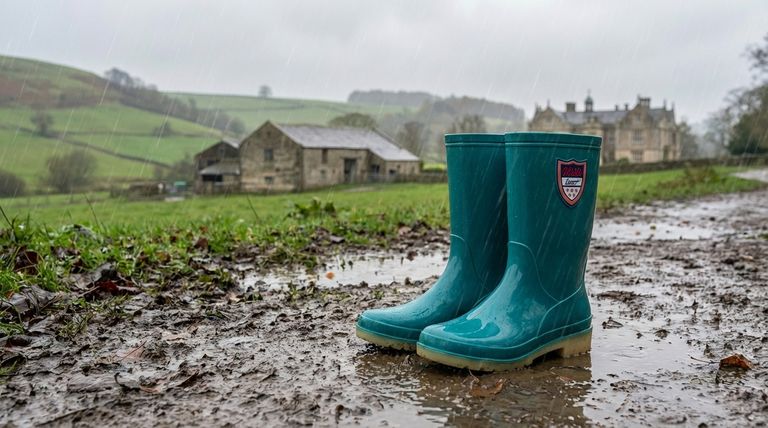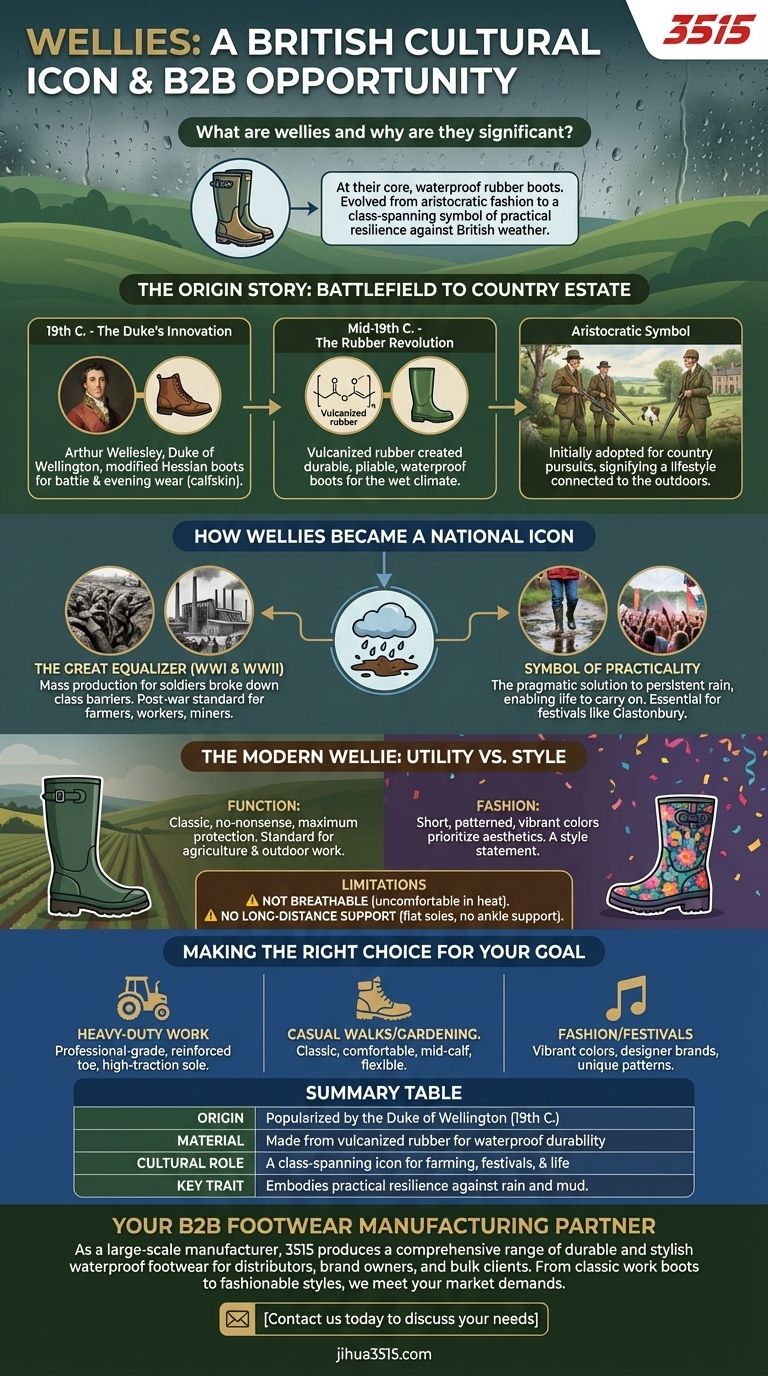At their core, wellies are waterproof rubber boots, but their deep significance in British culture comes from their unique evolution from an aristocratic fashion accessory into a class-spanning symbol of practical resilience against the infamous British weather. Originally popularized by Arthur Wellesley, the first Duke of Wellington, they have become an indispensable tool for navigating the nation's damp and muddy landscape.
The Wellington boot's journey from a Duke's custom footwear to a national necessity for farmers, festival-goers, and families alike is what makes it a true cultural icon—a shared solution to the common problem of mud and rain.

The Origin Story: From Battlefield to Country Estate
The Duke's Practical Innovation
The story begins with Arthur Wellesley, the first Duke of Wellington, in the early 19th century. He instructed his shoemaker to modify the standard issue Hessian boot, creating a more practical, close-fitting design made from soft calfskin leather that was comfortable for battle yet smart enough for evening wear.
The Shift to Rubber
The boot's transformation into the modern wellie occurred with the advent of vulcanized rubber in the mid-19th century. This new process created a durable, pliable, and fully waterproof material, perfect for crafting boots designed to withstand the wet British climate.
An Aristocratic Symbol
Initially, these new rubber boots were adopted by the aristocracy and landed gentry for country pursuits like hunting and shooting. They were a status symbol, signifying a lifestyle connected to the great outdoors and large country estates.
How Wellies Became a National Icon
The Great Equalizer
The wellie's transition from a luxury item to a national necessity was cemented during the World Wars. The British government commissioned vast quantities of them to protect soldiers from the mud and flooded conditions of the trenches.
This mass production made the boots widely available and affordable, breaking down class barriers. After the wars, they became standard-issue footwear for farmers, factory workers, and miners—anyone whose work involved wet and dirty conditions.
The Symbol of Practicality
More than anything, the wellie represents a pragmatic solution to a shared national experience: the weather. In a country known for its persistent rain, the wellie is the great enabler, allowing life to carry on regardless of the mud, puddles, or snow.
From Farms to Festivals
Today, the wellie's cultural status is renewed each year at outdoor music festivals like Glastonbury, where they are essential attire. They have also become a fashion item, available in countless colors and patterns, worn by everyone from royalty to toddlers jumping in puddles.
The Modern Wellie: Utility vs. Style
Function Over Fashion?
The classic wellie remains a purely functional item—a tall, green, no-nonsense boot designed for maximum protection. This traditional form is still the standard for agriculture and outdoor work.
However, the boot has also been embraced by the fashion world. Designer brands and high-street shops offer short, patterned, and brightly colored versions that prioritize aesthetics, turning a practical tool into a style statement.
Understanding Their Limitations
Despite their versatility, wellies are specialized footwear. They are not breathable, which can make them uncomfortable for all-day wear in warm conditions.
Furthermore, their flat soles and unstructured fit mean they are not designed for long-distance hiking or activities requiring significant ankle support. They solve the problem of water and mud, but not much else.
Making the Right Choice for Your Goal
Whether for work, leisure, or fashion, the modern wellie serves different purposes.
- If your primary focus is heavy-duty work or farming: Choose a professional-grade boot with a reinforced toe, high-traction sole, and durable construction.
- If your primary focus is casual country walks or gardening: A classic, comfortable, mid-calf wellie offers the ideal balance of protection and flexibility.
- If your primary focus is fashion or festivals: Consider vibrant colors, designer brands, or unique patterns that allow you to express personal style.
Ultimately, the wellie endures because it perfectly embodies the British spirit of carrying on, whatever the weather.
Summary Table:
| Aspect | Description |
|---|---|
| Origin | Popularized by the Duke of Wellington in the early 19th century. |
| Material | Made from vulcanized rubber for waterproof durability. |
| Cultural Role | A class-spanning icon for farming, festivals, and everyday life. |
| Key Trait | Embodies practical resilience against rain and mud. |
Need reliable, high-quality wellies for your business or brand?
As a large-scale manufacturer, 3515 produces a comprehensive range of durable and stylish waterproof footwear for distributors, brand owners, and bulk clients. Whether you need classic work boots or fashionable festival styles, our production capabilities encompass all types of shoes and boots to meet your market demands.
Contact us today to discuss your footwear needs and discover how we can support your business with quality manufacturing.
Visual Guide

Related Products
- Factory Direct Wholesale Rain Boots Durable Waterproof & Fully Customizable
- Factory-Direct Wholesale Canvas Boots with High-Traction Rubber Soles
- Wholesale Safety Footwear Manufacturer for Bulk & Custom OEM Orders
- Premium Flame-Retardant Waterproof Safety Boots and Shoes
- Premium Grain Leather Safety Boots for Bulk Supply
People Also Ask
- What variety of rubber boots is available? From Rain to Safety and Medical Solutions
- What are rain boots made of? Discover the best materials for ultimate waterproof protection.
- What are the limitations of rain boots in certain climates? Find the Right Footwear for Your Weather
- What are the characteristics of rubber as a rain boot material? Discover Its Durability & Flexibility
- What are the main materials used in the production of rain boots? A Guide to Durability & Comfort



















